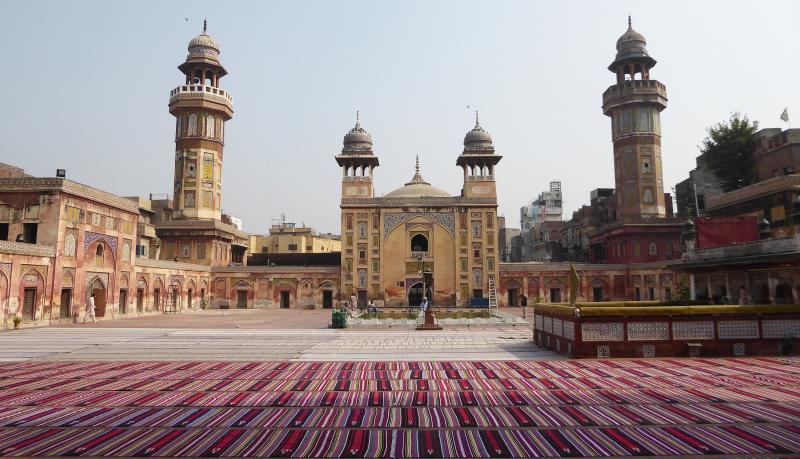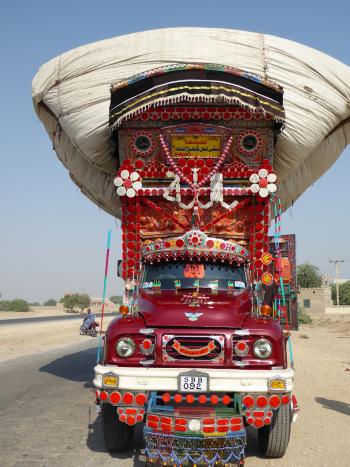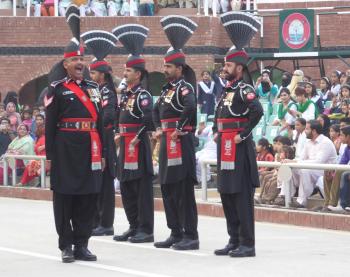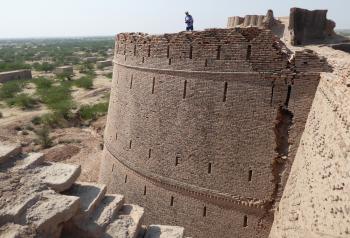A long-anticipated trip to Pakistan proves worth the wait
This article appears on page 6 of the December 2017 issue.
I’ve traveled to many of the wild, exotic and “Why on Earth would you go there?” places in the world, including Iraq, Iran, Syria, Sudan and Libya, but there was one destination I’d been wanting to visit for a long time that had always eluded me. But not anymore!
In October 2016, I traveled to Pakistan with Spiekermann Travel (Eastpointe, MI; 800/645-3233, www.mideasttrvl.com).
I have taken many trips with Spiekermann and have always been pleased with their services, so when I saw that they were offering an 18-day trip down the Indus River, from Gilgit in the north of Pakistan to Karachi in the south, I jumped at the chance.
The logistics
Our group consisted of only eight travelers, several of whom I knew from other trips, along with our lecturer, Professor Denise Schmandt-Besserat, a professor emerita of Art History and Middle Eastern Studies at the University of Texas at Austin. We would meet in Islamabad and fly home from Karachi.
The journey would take us from the north, beginning in the mountainous Hunza region, along the spine of the country from Islamabad to Lahore and on to Karachi on the Arabian Sea. It would be a trip of mountains and water, mosques and shrines, museums and palaces.
The trip cost $8,500, which included international airfare from New York, plus another $800 for a single supplement. I decided to make my own international air arrangements, flying through Doha, Qatar, and received a $900 air credit.
With the assistance of Spiekermann Travel, I obtained my Pakistani visa prior to departure for around $200. This was not an easy task, since I had an Indian visa in my passport and India and Pakistan are not exactly allies, but since I live in Chicago, where Pakistan maintains a consulate office, I was able to get the required visa in the nick of time.
Having made the long journey from the US to Pakistan, our small group could not have been better taken care of by local tour company owner Didar Ali of Silk Route Expeditions and his amazing colleagues, Kareem (our guide), Shifa (our naturalist) and Furcaan (Didar’s son and our resident aide, assistant and technology expert, who fixed all of our cameras and ran back to the van to fetch sweaters and hats and made sure we all had plenty of water to drink throughout the trip).
The infrastructure in Pakistan was really quite good. We traveled north from Islamabad and back on a small plane, flying through some of the most gorgeous mountains, and Didar made sure we all had window seats.
Whenever we drove, the roads we traveled on were in good condition, and we were able to stay on schedule most of the time, absent the occasional blocked road or washed-out bridge. The hotels ranged from luxurious, in Karachi, Lahore and Islamabad, to basic (but always clean) in some of the smaller towns.
The food was exceptional and very similar to Indian food but with its own unique flavors.
The highlights of the trip, however, were the sights, which were some of the most beautiful historical, cultural and exotic sights I’ve come upon in all of my travels.
The north
We spent the first four days where three mountain ranges — the Karakoram, the Hindu Kush and the Himalayas — intersected. Gilgit, the capital of Gilgit-Baltistan, a territory disputed between India and Pakistan, was our base.
From there we traveled in 4x4 vehicles along the Karakoram Highway farther north to Khunjerab Pass, one of the highest passes in the world, linking Pakistan and China. The views were exquisite, and in the ensuing days we photographed glaciers, visited forts, shopped at local bazaars, studied ancient rock carvings and trekked to see a Buddha carved high in the mountains, all while enjoying short presentations given by Denise on the bus or in a hotel lobby.
Then we returned to Islamabad, the current capital of Pakistan, a clean and modern city with organized grid-like streets built during the 1960s to replace Karachi as the capital. We visited its modern and architecturally significant Shah Faisal Mosque and a couple of interesting museums before continuing south along the old Grand Trunk Road.
We enjoyed a full day visiting Taxila, a Hellenistic city along what used to be the ancient trade route, which offered a few well-preserved ruins and a well-curated museum. Taxila is associated with the famous Gandhara style of Buddhist art, and examples of this were everywhere.
Lahore
Our next destination was Lahore, and along the way we visited a lovely Hindu temple complex and the Khewra Salt Mine, the second-largest salt mine in the world. We toured the site by small train and on foot, and I found it interesting and unexpected.
I was especially thrilled with our visit to Lahore, where we spent a fast-paced 2½ days. Lahore served as one of the capitals of the Mughal Empire, and the buildings they left behind are stunning.
Starting at the Lahore Fort, which was more run-down than the forts in India though somehow more romantic because of that, our group continued on to visit ancient baths and two stunning mosques, Badshahi Mosque and Wazir Khan Mosque. Our days were packed with wonderful sights.
I particularly enjoyed a leisurely rooftop lunch at a restaurant called Cooco’s Den, located in Lahore’s former red-light district. The restaurant was opened by the son of a former courtesan who wanted to honor his mother’s memory. There was a small museum on the main floor, and the restaurant was a healthy climb up on an open terrace with views of the Badshahi Mosque across the street. The food was wonderful.
Later on during our stay in Lahore, we had lunch outdoors at the Mughal Shalimar Gardens, then drove to Wagah on Pakistan’s border with India for the flag-lowering ceremony, which involved a lot of pageantry and bravado.
Ancient sites and shrines
The best was still to come, however: our introduction to ancient Indus Valley civilizations at Harappa and Mohenjo-daro.
These Bronze Age sites, which flourished from 3300 to 1300 BC, were contemporaneous with ancient Mesopotamia, China and Egypt and were home to some of the first great urban civilizations in the ancient world, complete with religious buildings, baths, drainage systems, granaries, arcane writing and beautiful art, like the sculpture of the Harappan dancing girl presently on display in Delhi and the famous priest-king statue in Karachi.
Both sites were well-preserved, with good museums and paved walkways for making your way along the ruins.
Throughout our Pakistan tour, we spent a good deal of time visiting Islamic tombs and shrines. The mausoleums at Multan, with their elaborate domes and colorful geometric tiles, were a photographer’s dream. The tombs at Uch Sharif, especially in the late-afternoon light, were mesmerizing.
We visited several Sufi shrines where pilgrims still go to pray and worship, but I’m afraid our group was somewhat disruptive because we became the main focus wherever we arrived. Once smiles were exchanged, the locals were as anxious to take photos of us as we were of them.
On a sad note, only four months after our visit, one of the shrines we visited, the shrine of Lal Shahbaz Qalander, was the site of a suicide bombing that resulted in the deaths of scores of pilgrims.
In the city of Thatta, we visited the Grand Mosque of Shah Jahan, an architectural marvel, and the stunning necropolis at Makli Hill, where, due to the light, the photos took themselves.
I would be remiss if I didn’t also mention the forts. We visited two: Derawar and Kot Diji. These massive structures in the Cholistan Desert were breathtaking.
Coming to a close
Our final days were spent in Karachi. There, we visited Jinnah’s Tomb (aka Mazar-e-Quaid) and the National Museum of Pakistan, where we saw the actual priest-king statue from Mohenjo-daro, among other sights. We had lunch at the seashore, and there was plenty of time to ride a camel in the sand and dip our toes in the Arabian Sea.
So how would I sum up a trip to a country that most people are hesitant to visit? I would say that Pakistan is a strikingly beautiful country with significant historical and cultural sights and wonderful scenic beauty. I learned a lot, took a lot of pictures, ate a lot of good food and thoroughly enjoyed myself.
At no time did I feel unsafe or unwelcome. At times, we had a police escort with us, but I think that was out of extreme caution. Never did I encounter anything but warmth and generosity of spirit from the local people… after the shock of seeing our group of foreigners had worn off!
This trip definitely goes into my “trips of a lifetime” category, and I would highly recommend a visit to Pakistan.




